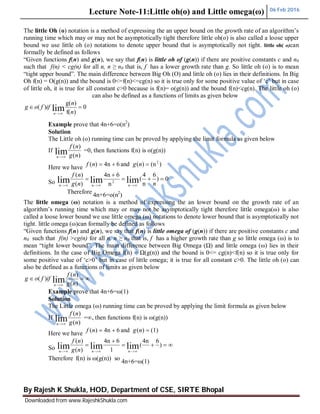
Little o and little omega
- 1. Lecture Note-11:Little oh(o) and Little omega(ω) 06 Feb 2016 By Rajesh K Shukla, HOD, Department of CSE, SIRTE Bhopal Downloaded from www.RajeshkShukla.com The little Oh (o) notation is a method of expressing the an upper bound on the growth rate of an algorithm’s running time which may or may not be asymptotically tight therefore little oh(o) is also called a loose upper bound we use little oh (o) notations to denote upper bound that is asymptotically not tight. little oh( o)can formally be defined as follows “Given functions f(n) and g(n), we say that f(n) is little oh of (g(n)) if there are positive constants c and n0 such that f(n) < cg(n) for all n, n ≥ n0 that is, f has a lower growth rate than g. So little oh (o) is to mean “tight upper bound”. The main difference between Big Oh (O) and little oh (o) lies in their definitions. In Big Oh f(n) = O(g(n)) and the bound is 0<=f(n)<=cg(n) so it is true only for some positive value of ‘c’ but in case of little oh, it is true for all constant c>0 because is f(n)= o(g(n)) and the bound f(n)<cg(n). The little oh (o) can also be defined as a functions of limits as given below Example prove that 4n+6=o(n2 ) Solution The Little oh (o) running time can be proved by applying the limit formula as given below If )( )( lim ng nf n =0, then functions f(n) is o(g(n)) Here we have )(n)(and64n)( 2 ngnf So 0) 6 n 4 ( n 64n )( )( limlimlim 2 nng nf nnn Therefore 4n+6=o(n2 ) The little omega (ω) notation is a method of expressing the an lower bound on the growth rate of an algorithm’s running time which may or may not be asymptotically tight therefore little omega(ω) is also called a loose lower bound we use little omega (ω) notations to denote lower bound that is asymptotically not tight. little omega (ω)can formally be defined as follows “Given functions f(n) and g(n), we say that f(n) is little omega of (g(n)) if there are positive constants c and n0 such that f(n) >cg(n) for all n, n ≥ n0 that is, f has a higher growth rate than g so little omega (ω) is to mean “tight lower bound”. The main difference between Big Omega (Ω) and little omega (ω) lies in their definitions. In the case of Big Omega f(n) = Ω(g(n)) and the bound is 0<= cg(n)<f(n) so it is true only for some positive value of ‘c>0’ but in case of little omega; it is true for all constant c>0. The little oh (o) can also be defined as a functions of limits as given below )( )( )( lim ng nf iffog n Example prove that 4n+6=ω(1) Solution The Little omega (ω) running time can be proved by applying the limit formula as given below If )( )( lim ng nf n =∞, then functions f(n) is ω(g(n)) Here we have (1))(and64n)( ngnf So ) 64n ( 1 64n )( )( limlimlim nnn ng nf Therefore f(n) is ω(g(n)) so 4n+6=ω(1) 0 )f( )g( )( lim n n iffog n
